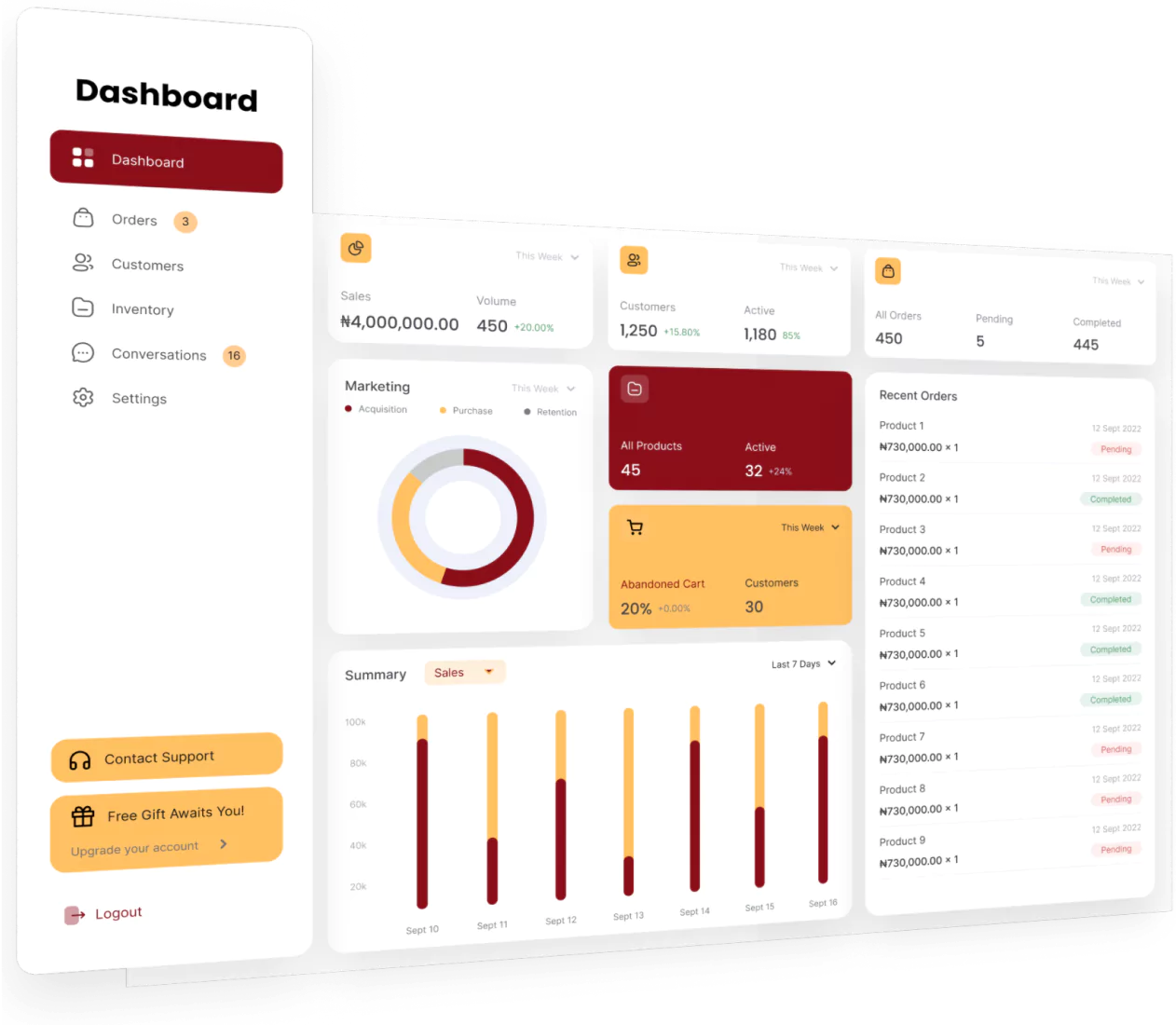Imagine your construction project running without structured oversight. Materials arrive late, subcontractors are confused about their roles, and timelines are constantly shifting. This kind of chaos not only delays completion but can result in severe cost overruns and reputational damage.
In Malaysia, the demand for well-managed construction services is on the rise, driven by rapid development across various sectors. According to the Department of Statistics Malaysia (DOSM), the construction sector recorded a work value of RM41.1 billion in Q3 2024, marking a 22.9% increase compared to the previous quarter.
This article discusses the definition of a general contractor, the key responsibilities, and the benefits of using construction management software to support their work. After reading this article, you will have a comprehensive understanding of what a general contractor is and how they contribute to the successful execution of construction projects.
Key Takeaways
|
Table of Content
Content Lists
What is a General Contractor?
A general contractor is a licensed professional or firm responsible for managing construction projects from start to finish. They act as the central authority—coordinating timelines, labor, budgeting, and subcontractors to ensure efficient project delivery.
General contractors provide peace of mind for business owners by overseeing every step of the construction journey. Unlike a renovation contractor, who may only handle small-scale upgrades or remodeling, general contractors manage full-scale builds.
This includes everything from obtaining permits to post-construction cleanup. Whether it’s a commercial facility, residential tower, or retail center, general contractors must ensure that the project meets safety, regulatory, and quality standards.
In Malaysia, general contractors must meet strict requirements under the BCA registration framework. These standards are in place to maintain quality and safety, especially in public infrastructure projects. Many adopt advanced construction management guidelines to ensure smooth project execution and stakeholder alignment.
Key Responsibilities of a General Contractor
A general contractor wears many hats, ensuring every component of a construction project is running according to plan. Below are the core duties typically handled by building contractors:
1. Project planning and scheduling
General contractors create detailed schedules that outline project phases, deadlines, and resource needs. They coordinate labor, materials, and equipment to ensure that tasks are completed without delays. This planning minimizes disruptions and keeps the project on track from start to finish.
2. Budgeting and construction estimating
They prepare accurate construction estimating reports covering labor, materials, and unforeseen costs. This helps clients manage expenses efficiently and avoid overruns. Well-estimated budgets provide financial clarity and reduce risks throughout the project lifecycle.
3. Subcontractor coordination
General contractors oversee subcontractors such as renovation contractors, electricians, and plumbers to ensure smooth collaboration. They assign responsibilities, monitor daily progress, and address on-site challenges. Effective coordination results in higher productivity and consistent quality.
4. Regulatory compliance and safety
They ensure the project complies with safety laws and building regulations while minimizing legal risks. This includes proper documentation, worker training, and regular site inspections. A strong focus on compliance promotes a safe working environment and prevents costly delays.
Still unsure whether a construction management system is the right fit for your projects? No worries! Try a pricing scheme today and consult with our experts to explore how this solution can transform the way you manage construction operations. Click the banner below to get started!
General Contractor vs Renovation Contractor
While both general and renovation contractors operate in the construction industry, their roles differ significantly in terms of scope and responsibility. Understanding this distinction helps businesses hire the right professional for the job.
General contractors oversee the entire building process, from structural work to finishing touches. They manage large teams and ensure the project aligns with architectural plans, engineering standards, and budget goals.
In contrast, renovation contractors typically handle smaller, specialized tasks like upgrading office interiors, repainting, or fitting new plumbing. They’re ideal for projects that don’t require full construction oversight.
For businesses undertaking ground-up development or major structural expansion, hiring a general contractor is essential for complete project control and long-term value.
Benefits of Using Construction Management Software

Incorporating construction management software into project execution has become a game-changer for contractors. These digital platforms streamline real-time communication, documentation, and progress tracking. By automating and centralizing key functions, they enhance accuracy, efficiency, and decision-making across all construction phases.
1. Centralized project oversight
All project data, including schedules, documents, and updates, is stored in one unified platform. This makes it easier for stakeholders to monitor progress and identify issues early. A centralized system reduces confusion and improves overall coordination among teams.
2. Accurate construction estimating
The software provides built-in construction estimating tools that calculate real-time costs based on updated project data. This enhances budgeting precision and helps avoid cost overruns. With clear cost visibility, contractors can make more confident financial decisions.
3. Improved communication and collaboration
Project teams, subcontractors, and clients can communicate through integrated messaging and task management features. This eliminates delays caused by miscommunication or missed updates. Better collaboration leads to faster approvals and smoother project execution.
4. Real-time reporting and analytics
Users can generate instant reports on budgets, schedules, resource use, and performance metrics. These insights support faster, data-driven decisions and highlight potential bottlenecks. Real-time analytics ensure that adjustments are made before issues escalate.
5. Enhanced document management
Construction management software organizes contracts, blueprints, RFIs, and compliance documents in a structured system. This reduces the risk of losing important files and ensures quick retrieval when needed. Efficient documentation helps maintain legal and regulatory compliance.
The Importance of Construction Management Guidelines
Adhering to proven construction management guidelines ensures that every project phase meets industry standards and client expectations. These frameworks establish best practices for planning, communication, quality control, and safety. They serve as a roadmap to minimize errors and deliver predictable outcomes.
Standard guidelines cover essential areas like pre-construction risk assessments, resource allocation, quality assurance protocols, and post-construction evaluations. Consistently following these principles leads to better efficiency, accountability, and stakeholder satisfaction. Moreover, it aligns the entire team with clearly defined roles and responsibilities.
Companies that enforce strict adherence to management guidelines benefit from fewer project delays, reduced costs, and improved team coordination. These guidelines are a cornerstone of successful project delivery through manual processes or advanced construction management software.
Improve Construction Efficiency and Accuracy with HashMicro Construction Software

Coordinating budgets, schedules, and teams across multiple construction sites can be overwhelming without the right tools. Manual tracking often leads to delays, miscommunication, and budget overruns.
HashMicro’s Construction Management Software offers an all-in-one solution for contractors, renovation contractors, and building contractors. It automates workflows, provides real-time project tracking, and complies with construction management guidelines.
Let’s take a closer look at the key features of HashMicro’s Construction Project Management Software:
1. Comprehensive tender and contract management
This feature makes it easy to track tender submission status and important deadlines. With integrated submission tools, the tender process becomes more efficient. In addition, project contracts can be drafted, reviewed, and completed more quickly and neatly.
2. Optimized purchasing management
An approval matrix is used to control the purchasing process based on project needs in a structured manner. Online vendor portals facilitate the comparison of bids from various suppliers to get the best price. All procurement activities are centralized in an efficient and easy-to-use e-procurement system.
3. Real-time project monitoring
You can monitor project progress in real time, including budget and timeline. Work assignments can be managed efficiently between projects. Project progress is visualized in the form of an S-curve report, and a project claim feature is also available for cost reporting.
4. Efficient material management
Material management includes direct and accurate stock monitoring. This system can also predict material needs and provide automatic ordering suggestions. The delivery and use of materials at various project locations can be tracked comprehensively.
5. Advanced financial and budgeting tools
This software helps to make accurate project cost estimates. Project expenses can be monitored in real time to stay within budget. Integrated accounting features support financial reporting and compliance for multiple business branches.
Conclusion
General contractors play a vital role in the success of construction projects by managing timelines, coordinating subcontractors, and ensuring compliance with construction management guidelines. Their ability to oversee all aspects of a project, from budgeting to execution, is essential in delivering results on time and within budget.
With HashMicro’s Construction Management Software, contractors, renovation contractors, and building contractors can automate workflows, improve construction estimating accuracy, and centralize project data. The system provides real-time insights, streamlined communication, and efficient resource management across every job site.
HashMicro is an innovative solution for construction management, from precise planning to successful project delivery. With advanced features tailored for the industry, it boosts accuracy, speeds up operations, and reduces costly errors. Try a free demo today and transform the way you manage construction projects!
Question About General Contractor
-
How much do most general contractors make?
In Malaysia, general contractors typically earn between RM60,000 and RM120,000 annually, depending on their level of experience, the complexity of the projects they manage, and the size of the construction firm. Those handling large-scale developments or working with established companies may also receive performance-based bonuses and additional project allowances, increasing their overall compensation.
-
What is the difference between a general contractor and a project manager?
A general contractor oversees the construction work, manages subcontractors, and ensures legal and safety compliance. A project manager focuses more on planning, budgeting, and communication with stakeholders to ensure the project stays on track.
-
What type of contractor makes the most money?
Specialized contractors such as electrical, HVAC, and structural contractors typically earn more due to the technical expertise required. Design-build contractors and those handling large commercial projects also tend to have higher profit margins.
-
What does a contractor do?
A contractor manages construction work by organizing labor, materials, and equipment. Their responsibilities include hiring subcontractors, interpreting blueprints, ensuring timely project delivery, and adhering to building codes.






































